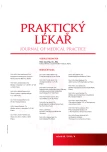Comparison of health literacy in selected groups of individuals
Authors:
R. Belešová; D. Filausová; M. Trešlová
Authors‘ workplace:
Jihočeská univerzita v Českých Budějovicích, Zdravotně sociální fakulta, Ústav ošetřovatelství, porodní asistence a neodkladné péče, Ředitelka: prof. PhDr. Valérie Tóthová, Ph. D.
Published in:
Prakt. Lék. 2019; 99(4): 175-180
Category:
Of different specialties
Overview
Aim: Health literacy is seen as the ability of people to acquire, evaluate and apply adequate health information. Provides people with the ability to judge and make decisions about health care, disease prevention as well as health promotion to preserve and improve their quality of life. There are a number of factors involved in the level of health literacy of the population, such as age, gender, education, place of residence as well as cultural and economic conditions.
Goal: The paper studies and compares the level of health literacy in selected groups of individuals, particularly in adults and the poor.
Methods: The study used a quantitative method using a standardized 16-item questionnaire (one-dimensional Rasch-scale) to identify the population’s health literacy. The resulting scale for the abbreviated questionnaire contained 16 items. Based on this scale, 3 basic health literacy levels were set: (1) insufficient health literacy level (0–8 points), (2) marginal health literacy level (9–12 points), and (3) sufficient health literacy level (13–16 points). Statistic data processing was performed using the SASD software. The adult sample consisted of 303 respondents at the age between 18 and 64 years. The sample of the poor contained 300 respondents (18 and older).
Results: The statistic results showed that insufficient health literacy had been revealed in 17.5% of the adult respondents, compared with 31.9% in the group of the poor. Marginal health literacy was found in 31.5% of the former group and 34.3% of the latter group. Sufficient health literacy was proven in 51.0% of the adult respondents and only in 33.8 % of the respondents living below the poverty line.
Conclusions: Based on a mutual comparison of study results of the selected population groups (group 1 – adults, group 2 – the poor), insufficient health literacy is obvious in the poor as compared with the standard adult population. An essential finding is the fact that the degree of health literacy is, beside the age, education, occupation and healthy life style, influenced by the economic situation and social status.
Keywords:
Adults – comparison – health literacy – poverty
Sources
1. Berkman ND, Sheridan SL, Donahue KE, et al. Low health literacy and health outcomes: An updated systematic review. Ann Intern Med 2011; 155(2): 97–107.
2. Dupre ME, Goerge LK. Exceptions to the rule: exceptional health among the disadvantaged. Res Aging 2011; 33(2): 115–144.
3. Hays RD, Spritzer KL, Amtmann D, et al. Upper extremity and mobility subdomains from the Patient-Reported Outcomes Measurement Information System (PROMIS) adult physical functioning item bank. Arch Phys Med Rehabil 2013; 94 : 2291–2296.0
4. Holčík J. Přehled vybraných aktivit v oblasti zdravotní gramotnosti. 4–10 s. In: Zdravotní gramotnost a zdravotní politika. Sborník textů pro kolokvium [on line]. Praha: Ústav pro zdravotní gramotnost, z.ú. Institut postgraduálního vzdělávání ve zdravotnictví, 2017. Dostupné z: http://www.uzg.cz/doc/Kolokvium_Sbornik.pdf [cit. 2019-08-01].
5. Holčík J. Sociální lékařství, veřejné zdravotnictví a řízení péče o zdraví. Čas. Lék. čes. 2016; 155(5): 229–232.
6. Knighton AJ, Brunisholz KD, Savitz TZ. Detecting risk of low health literacy in disadvantaged populations using area-based measures. EGEMS (Wash DC) 2017; 5(3): 7.
7. Kučera Z, Pelikan J, Šteflová A. Zdravotní gramotnost obyvatel ČR – výsledky komparativního reprezentativního šetření. Čas. Lék. čes. 2016; 155(5): 233–241.
8. Menendez ME, Bastiaan T, van Hoorn BS, et al. Patients with limited health literacy ask fewer questions during office visits with hand surgeons. Clin Orthop Relat Res 2017; 475 : 1291–1297.
9. Ministerstvo zdravotnictví ČR. Zdraví 2020. Národní strategie ochrany a podpory zdraví a prevence nemocí. Akční plán č. 12: Rozvoj zdravotní gramotnosti na období 2015–2020 [online]. Dostupný z: http://www.mzcr.cz/Admin/_upload/files/5/akční plány - přílohy/AP 12 rozvoj zdravotní gramotnosti.pdf [cit. 2019-05-01].
10. Rikard RV, Thompson MS, McKinney J, Beauchamp A. Examining health literacy disparities in the United States: a third look at the National Assessment of Adult Literacy (NAAL). BMC Public Health 2016; 16 : 975.
Labels
General practitioner for children and adolescents General practitioner for adultsArticle was published in
General Practitioner

2019 Issue 4
- Hope Awakens with Early Diagnosis of Parkinson's Disease Based on Skin Odor
- Metamizole at a Glance and in Practice – Effective Non-Opioid Analgesic for All Ages
- Memantine in Dementia Therapy – Current Findings and Possible Future Applications
- Metamizole vs. Tramadol in Postoperative Analgesia
- Memantine Eases Daily Life for Patients and Caregivers
-
All articles in this issue
- Risk factors of falls of hospitalized patients
- Trends and correlates of obesity in Czech adolescents in relation to family socioeconomic status between 2002–2018
- Silver nanoparticles prepared by green synthesis and synergistic effect with antibiotic as the basis of nanoconstruct for the treatment of bacterial infections
- Opinions of Czech citizens on selected activity aspects of general practicioners – 2018
- Employee benefits from the perspective of health care workers in the ambulatory sphere
- Care for patients with lymphedema in the Czech Republic – introduction
- Comparison of health literacy in selected groups of individuals
- Hippokratova přísaha a aktuální lékařské sliby
- Ceny Josefa Hlávky za rok 2018 uděleny
- Před 140 lety se narodil prof. PhDr. et MUDr. Vojtěch Suk, DrSc. (1879–1967), zakladatel Přírodovědeckého ústavu v Brně
- Stipendium nabízí až jeden milion korun průkopníkům a zkušeným profesionálům v oblasti paliativní péče
- Co byste měli vědět o rakovině prsu
- General Practitioner
- Journal archive
- Current issue
- About the journal
Most read in this issue
- Risk factors of falls of hospitalized patients
- Hippokratova přísaha a aktuální lékařské sliby
- Care for patients with lymphedema in the Czech Republic – introduction
- Employee benefits from the perspective of health care workers in the ambulatory sphere
